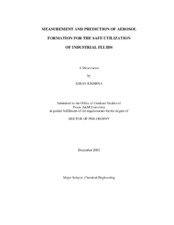| dc.description.abstract | Mist or aerosol explosions present a serious hazard to process industries. Heat transfer fluids are widely used in the chemical process industry, are flammable above their flash points, and can cause aerosol explosions. Though the possibility of aerosol explosions has been widely documented, knowledge about their explosive potential is limited. Studying the formation of such aerosols by emulating leaks in process equipment will help define a source term for aerosol dispersions and aid in characterizing their explosion hazards.
Analysis of the problem of aerosol explosions reveals three major steps: source term calculations, dispersion modeling, and explosion analysis. The explosion analysis, consisting of ignition and combustion, is largely affected by the droplet size distribution of the dispersed aerosol. The droplet size distribution of the dispersed aerosol is a function of the droplet size distribution of the aerosol formed from the leak. Existing methods of dealing with the problem of aerosol explosions are limited to enhancing the dispersion to prevent flammable concentrations and use of explosion suppression mechanisms. Insufficient data and theory on the flammability limits of aerosols renders such method speculative at best. Preventing the formation of aerosol upon leaking will provide an inherently safer solution to the problem.
The research involves the non-intrusive measurement of heat transfer fluid aerosol sprays using a Malvern Diffraction Particle Analyzer. The aerosol is generated by plain orifice atomization to simulate the formation and dispersion of heat transfer fluid aerosols through leaks in process equipment. Predictive correlations relating aerosol droplet sizes to bulk liquid pressures, temperatures, thermal and fluid properties, leak sizes, and ambient conditions are presented. These correlations will be used to predict the conditions under which leaks will result in the formation of aerosols and will ultimately help in estimating the explosion hazards of heat transfer fluid aerosols. Heat transfer fluid selection can be based on liquids that are less likely to form aerosols. Design criteria also can incorporate the data to arrive at operating conditions that are less likely to produce aerosols. The goal is to provide information that will reduce the hazards of aerosol explosions thereby improving safety in process industries. | en |


